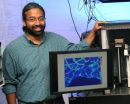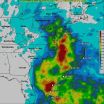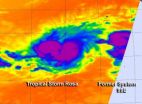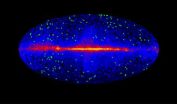(Press-News.org) AMES, Iowa – The human body has more than a trillion cells, most of them connected, cell to neighboring cells.
How, exactly, do those bonds work? What happens when a pulling force is applied to those bonds? How long before they break? Does a better understanding of all those bonds and their responses to force have implications for fighting disease?
Sanjeevi Sivasankar, an Iowa State assistant professor of physics and astronomy and an associate of the U.S. Department of Energy's Ames Laboratory, is leading a research team that's answering those questions as it studies the biomechanics and biophysics of the proteins that bond cells together.
The researchers discovered three types of bonds when they subjected common adhesion proteins (called cadherins) to a pulling force: ideal, catch and slip bonds. The three bonds react differently to that force: ideal bonds aren't affected, catch bonds last longer and slip bonds don't last as long.
The findings have just been published by the online Early Edition of the Proceedings of the National Academy of Sciences.
Sivasankar said ideal bonds – the ones that aren't affected by the pulling force – had not been seen in any previous experiments. The researchers discovered them as they observed catch bonds transitioning to slip bonds.
"Ideal bonds are like a nanoscale shock absorber," Sivasankar said. "They dampen all the force."
And the others?
"Catch bonds are like a nanoscale seatbelt," he said. "They become stronger when pulled. Slip bonds are more conventional; they weaken and break when tugged."
In addition to Sivasankar, the researchers publishing the discovery are Sabyasachi Rakshit, an Iowa State post-doctoral research associate in physics and astronomy and an Ames Laboratory associate; Kristine Manibog and Omer Shafraz, Iowa State doctoral students in physics and astronomy and Ames Laboratory student associates; and Yunxiang Zhang, a post-doctoral research associate for the University of California, Berkeley's California Institute for Quantitative Biosciences.
The project was supported by a $308,000 grant from the American Heart Association, a $150,000 Basil O'Connor Award from the March of Dimes Foundation and Sivasankar's Iowa State startup funds.
The researchers made their discovery by taking single-molecule force measurements with an atomic force microscope. They coated the microscope tip and surface with cadherins, lowered the tip to the surface so bonds could form, pulled the tip back, held it and measured how long the bonds lasted under a range of constant pulling force.
The researchers propose that cell binding "is a dynamic process; cadherins tailor their adhesion in response to changes in the mechanical properties of their surrounding environment," according to the paper.
When you cut your finger, for example, cells filling the wound might use catch bonds that resist the pulls and forces placed on the wound. As the forces go away with healing, the cells may transition to ideal bonds and then to slip bonds.
Sivasankar said problems with cell adhesion can lead to diseases, including cancers and cardiovascular problems.
And so Sivasankar said the research team is pursuing other studies of cell-to-cell bonds: "This is the beginning of a lot to be discovered about the role of these types of interactions in healthy physiology as well as diseases like cancer."
INFORMATION:
Contacts:
Sanjeevi Sivasankar, Physics and Astronomy, Ames Laboratory, 515-294-1220, sivasank@iastate.edu
Mike Krapfl, News Service, 515-294-4917, mkrapfl@iastate.edu
Iowa State, Ames Lab researchers find 3 unique cell-to-cell bonds
2012-11-02
ELSE PRESS RELEASES FROM THIS DATE:
NASA adds up Hurricane Sandy's rainfall from space
2012-11-02
NASA's Tropical Rainfall Measuring Mission, or TRMM, satellite acts as a rain gauge in space as it orbits the Earth's tropics. As TRMM flew over Hurricane Sandy since its birth on Oct. 21 it was gathering data that has now been mapped to show how much rain the storm dropped along the U.S. eastern seaboard.
Much of the recent deadly flooding along the northeastern United States coastlines was caused by super storm Sandy's storm swell. Strong winds from Sandy persistently pushed Atlantic Ocean waters toward the coast. High tides that occurred at the same time also magnified ...
NASA sees Tropical Storm Rosa's rains southeast of center
2012-11-02
Wind shear is pushing the bulk of Tropical Storm Rosa southeast of the storm's center, and that's evident on infrared imagery from NASA's Aqua satellite. Meanwhile System 99E, that was trailing behind Rosa on Oct. 31, has now "given up the ghost" as a result of that same wind shear.
When NASA's Aqua satellite flew over Tropical Storm Rosa at 5:41 a.m. EDT (0951 UTC) on Nov. 1, 2012 the Atmospheric Infrared Sounder (AIRS) instrument took an infrared picture of Tropical Storm Rosa and remnants of System 99E. The AIRS data showed the strongest convection (rising air that ...
Trickle-down anxiety: Study examines parental behaviors that create anxious children
2012-11-02
Parents with social anxiety disorder are more likely than parents with other forms of anxiety to engage in behaviors that put their children at high risk for developing angst of their own, according to a small study of parent-child pairs conducted at Johns Hopkins Children's Center.
Authors of the federally funded study say past research has linked parental anxiety to anxiety in children, but it remained unclear whether people with certain anxiety disorders engaged more often in anxiety-provoking behaviors. Based on the new study findings, they do. A report on the team's ...
NASA sees Tropical Depression Nilam blanket southern India
2012-11-02
After Tropical Cyclone Nilam made landfall in southeastern India NASA's Terra satellite passed overhead and saw the storm's clouds blanket the entire southern portion of the country from Chennai southward.
On Nov. 1 at 05:50 UTC (1:50 a.m. EDT), the Moderate Resolution Imaging Spectroradiometer (MODIS) instrument that flies aboard NASA's Terra satellite captured a visible image of Tropical Depression Nilam.
The MODIS image showed that Nilam's clouds stretched as far north as Andra Pradesh, a state in east central India. It covered the states of Goa and Karnataka in ...
Church-going teens go further with school
2012-11-02
For many American teens, the road to college goes through the chapel.
Sociologists from Brigham Young University and Rice University found religiously-affiliated youth are 40 percent more likely to graduate high school than their unaffiliated peers and 70 percent more likely to enroll in college.
The researchers note that teens' fellow church-goers are an important factor, serving as mentors who help teens set their sights high.
"Youth have a unique chance to form relationships with peers and mentors outside of their classroom at school or their neighborhood at home," ...
Suomi NPP satellite captures Hurricane Sandy's Mid-Atlantic blackout
2012-11-02
The Suomi National Polar-orbiting Partnership (NPP) satellitecaptured a night-time view of New York City, New Jersey and eastern Pennsylvania that revealed the extent of the power outages caused from Hurricane Sandy's landfall on October 29. Suomi NPP is a partnership between NASA, the National Oceanic and Atmospheric Administration (NOAA), and the U.S. Department of Defense.
The Visible Infrared Imaging Radiometer Suite (VIIRS) on Suomi NPP captured a night-time view of the Mid-Atlantic on the morning of Nov. 1, 2012,revealing areas where power has not been currently ...
NASA's Fermi measures cosmic 'fog' produced by ancient starlight
2012-11-02
VIDEO:
This animation tracks several gamma rays through space and time, from their emission in the jet of a distant blazar to their arrival in Fermi's Large Area Telescope (LAT). During...
Click here for more information.
Astronomers using data from NASA's Fermi Gamma-ray Space Telescope have made the most accurate measurement of starlight in the universe and used it to establish the total amount of light from all of the stars that have ever shone, accomplishing a primary ...
Asteroid belts of just the right size are friendly to life
2012-11-02
Solar systems with life-bearing planets may be rare if they are dependent on the presence of asteroid belts of just the right mass, according to a study by Rebecca Martin, a NASA Sagan Fellow from the University of Colorado in Boulder, and astronomer Mario Livio of the Space Telescope Science Institute in Baltimore, Md.
They suggest that the size and location of an asteroid belt, shaped by the evolution of the sun's protoplanetary disk and by the gravitational influence of a nearby giant Jupiter-like planet, may determine whether complex life will evolve on an Earth-like ...
Asia's newest megacity offers model for urban growth as populations swell worldwide
2012-11-02
Contact: Terry Collins
tc@tca.tc
416-538-8712
Malaysian Industry-Government Group for High Technology
Mansurah Raisa
raisa@might.org.my
60-0-166681210
Malaysian Industry-Government Group for High Technology
Diana Friedman
dfriedman@nyas.org
212-298-8645
New York Academy of Sciences
Asia's newest megacity offers model for urban growth as populations swell worldwide
Malaysia's low carbon Iskandar offers planning template for a planet with an urban population expected to double by 2050
Iskandar Malaysia, the first "smart metropolis" of Southeast ...
California Sales Tax Collectors to Target Online Merchants
2012-11-02
A new California sales tax law will require out-of-state online retailers to pay sales tax in California if they do substantial business with consumers in the state.
Previously, Internet merchants were only required to collect California sales tax if they maintained a physical presence in the state, such as a store or distribution center. As a result, many online merchants without physical ties to the state were able to avoid collecting sales tax on purchases from California customers, which some believe gave them an unfair advantage over businesses that are physically ...






